

| Santa Chiara is one of many new churches built after the city of Noto was virtually destroyed by the earthquake of 1693. Like the other new churches and palaces in the somewhat relocated city, San Francesco is designed in the reigning taste of the age--the Baroque style, and contributes to the unusual harmony and beauty of this reconstructed town, one of several in the Val di Noto, a geographical area now designated as a UNESCO World Heritage site. Like this church, most of the Baroque buildings are constructed of a soft tufa stone native to the area, which in the sun is a beautiful golden color. Santa Chiara is across the street from the Monastery of Santissimo Salvatore. The original entrance to the church was on the north side, but when the street level was lowered, this entrance was no longer usable. Thus, the entrance today is on west side--actually a side entrance to the church. | ||
The former entrance (north side) with the street lowered about 2 metersAlthough the facade is planar and sober, it does use classical pilasters on the corners carried through two stories and capped with a very non-classical capital (see below). The block is topped with a kind of bell tower. The somberness of the facade is somewhat mitigated by the ornamental portal and central window with its elaborate floral surround and inventive pediment of sorts. |
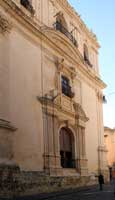
| |
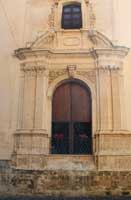
|
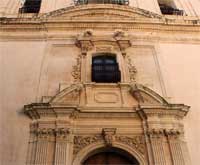
|
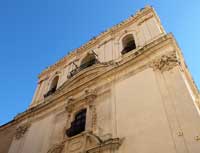
|

|
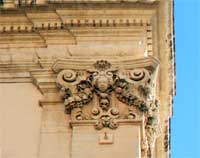
|
Left: the new entrance (west side) added in the late 18th century when it was learned that there were plans to lower the street on the north side; center: the exuberant capital of the giant corner pilasterSee bottom of page for commentary on this capital. |
Interior, looking toward the altarAlthough it is not evident from the exterior, which seems conventional, the interior plan is that of an oval. Columns frame the sanctuary and free-standing figures--the twelve apostles, standing on pedestals above the entablature, punctuate the arcs of the oval. | ||
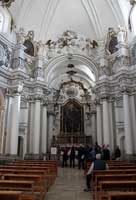
|
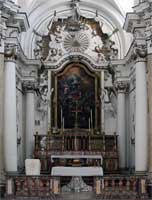
|
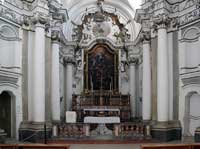
|
Center: four apostles here are James (with pilgrim's bundle?), Peter (with keys) and on the right, Andrew (cross) and John (with the chalice) |
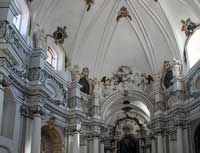
|
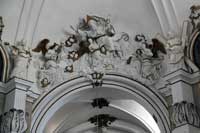
|
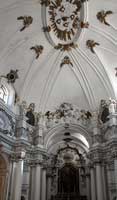
|
Tobriner's comments on the interior seem especially illuminating: "In contrast to the exterior of the church where no attention is paid to its iconography, in the interior Gagliardi united the iconography with the plan and interior elevation. The church is dedicated to S. Maria Assunta--the Virgin who rises into heaven after her death. The Assumption of the Virgin takes place in the painting on the altar, but the twelve apostles stand on columns around the nave, so in effect the Assumption occurs not only in the apse but also in the center of the church itself. Over the arch in the front of the altar God the Father looks out into the nave; angels and clouds appear at the top of the vault. In the spirit of his church and in the motifs he uses, Gagliardi appears to have been aware of the High Roman Baroque concept which Bernini popularized of the church as religious theater. The delicacy of this drama is protected from the outside world by the massive exterior of the church and the dormitory, which envelop it like a strongbox" (164). | |
Directly opposite the nave on the axis of the oval; right: possibly St Paul | ||
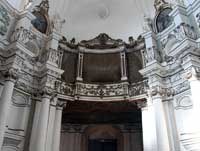
|
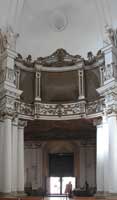
|

|
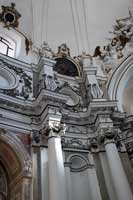
|
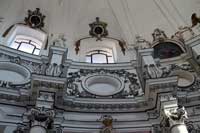
|
Decorative detail highlighted in gold and black paint |
| Of the capital above Tobriner has nothing good to say: "Either Gagliardi's stone carver did not interpret his drawing correctly or Gagliardi himself produced an unusually static capital design. In the carving of the capitals swiftness and delicacy are left behind for a slower rhythm in which distinct elements do not fuse together. Each equally weighted form contradicts the next: the heavy festoons break the upward movement of the acanthus leaves; whatever dynamism the volutes might have is contradicted by the compact and symmetrical cherub face which appears out of nowhere; the upper volutes cannot produce a directional energy because they are mimicked by lesser volutes which defuse them: they turn out and up while the ends of the shell between them turn down and out. On the bottom of the capital lesser volutes strapped together turn in and over while below tiny volutes turn in and up. It is no wonder the upper volutes seem static" (162). | ||
Works Consulted or Quoted:
The Baroque Art in Val di Noto [official guidebook] Palermo, n.d.
Grady, Ellen. Sicily [Blue Guide]. New York: Norton, 2006.
Tobriner, Stephen. The Genesis of Noto. London: Zwemmer, 1982.
 Click here to return to index of art historical sites.
Click here to return to index of art historical sites.
 Click here to return to index of artists and architects.
Click here to return to index of artists and architects.
 Click here to return to chronological index.
Click here to return to chronological index.
 Click here to see the home page of Bluffton College.
Click here to see the home page of Bluffton College.

